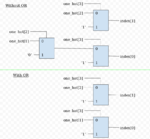promach
Advanced Member level 4

I am trying to understand how using 'or' avoids synthesizing priority encoder with the following circuit diagrams generated by yosys, Why would we have 31:2 bits of $10_Y mapped back to itself ? The verilog source code could be found below or https://www.edaplayground.com/x/4H6a
With OR

Without OR

- - - Updated - - -
What are actual purposes of the $or labelled $10 and $12 ?
With OR
Without OR

Code Verilog - [expand]
Code Verilog - [expand]
- - - Updated - - -
What are actual purposes of the $or labelled $10 and $12 ?

